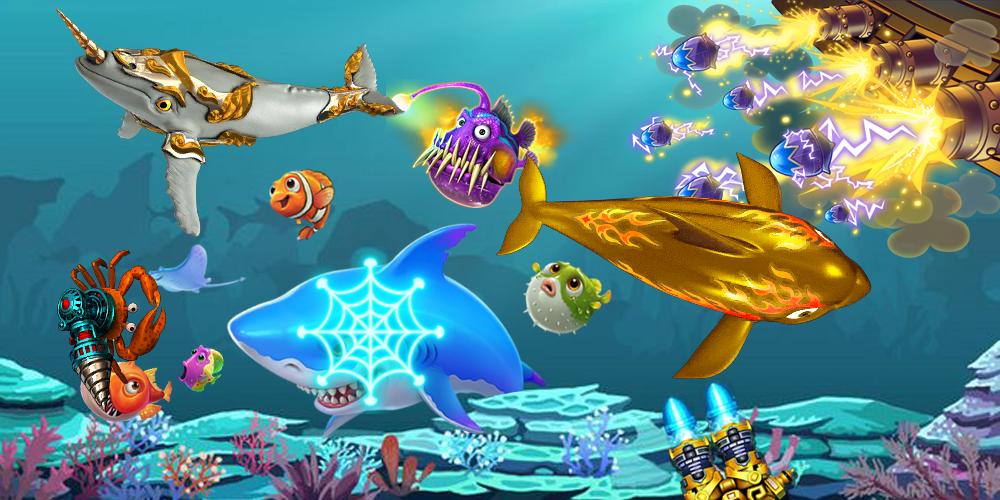Tembak Ikan Deposit Murah offers an accessible way for players to enjoy online fish shooting games with low minimum deposits, often starting from as little as 10,000 rupiah. This makes it appealing to a broad range of users who want to experience gambling without committing large sums of money.
The key advantage of Tembak Ikan Deposit Murah is that it combines affordable entry with the opportunity to win real money through engaging gameplay. Many platforms also provide features such as varied fish targets and bonus rounds that enhance the gaming experience while allowing players to manage their budget effectively.
Players can find multiple reputable sites that support these low deposits and offer smooth transactions, encouraging new and casual gamers to join. The combination of low cost and potential rewards creates a balanced environment for both entertainment and strategic play.
Understanding Tembak Ikan Deposit Murah
Tembak Ikan with a low deposit option allows players to start the game with minimal funds, making it accessible to a wider audience. The system combines straightforward gameplay mechanics with affordable entry points, enabling consistent play without significant financial risk.
What Is Tembak Ikan?
Tembak Ikan is an arcade-style online game that simulates shooting fish to earn rewards. Players aim and shoot at various fish swimming across the screen, each having different values and difficulty levels.
The objective is to accumulate points or coins by targeting fish efficiently. The game features simple controls and engaging visuals, appealing to casual and experienced players alike.
Definition of Deposit Murah
Deposit Murah refers to the low minimum deposit required to participate in Tembak Ikan games. This deposit can be as little as a few thousand rupiah, depending on the platform.
It allows players to fund their accounts with small amounts, reducing initial financial commitment. Many operators support deposit methods without extra fees or deductions, enabling full use of the deposited funds for gameplay.
How Tembak Ikan Games Work
Players begin by depositing funds into their account, often through quick and secure payment methods. Once credited, these funds are converted into in-game credits.
Using these credits, players select weapons to shoot at fish moving across the screen. Each fish type has a set point value; successful hits yield rewards based on this value.
The game may include bonuses, multipliers, and progressive levels to increase winning potential. Withdrawals are generally straightforward, allowing players to cash out winnings efficiently.
Benefits of Playing Tembak Ikan With Low Deposits
Playing Tembak Ikan with low deposits allows players to enjoy the game while minimizing financial risk. This approach supports better control over spending and makes the experience accessible to a wider audience, especially those new to the game.
Cost-Effective Entertainment
Low deposits reduce the initial amount a player must invest, making it easier to enjoy Tembak Ikan without a significant commitment. This affordability encourages prolonged gameplay, allowing users to experiment with different strategies without fearing large losses.
Players can manage their funds smartly, choosing to deposit small amounts multiple times rather than one large sum. This makes the game more appealing for those who want consistent entertainment without overspending.
Accessibility for Beginners
Low deposit requirements lower the entry barrier for new players. They can experience the game mechanics and test strategies without worry about losing large sums of money.
This accessibility encourages more users to try Tembak Ikan, gaining confidence over time. Also, it helps beginners learn important skills, such as aiming for bigger fish and managing ammunition in the game.
Flexible Budget Management
With small deposit options, players can more easily adapt their gaming budget based on their financial situation. They can scale their deposits up or down depending on their success or preference without feeling locked into large financial commitments.
This flexibility supports responsible gaming habits, allowing users to set limits and control their spending. It also helps in balancing entertainment with other financial priorities.
How to Find Trusted Tembak Ikan Deposit Murah Sites
Finding reliable platforms with affordable deposit options requires careful attention to specific qualities. These include clear operational standards, legal compliance, and verified user experiences. Trust builds on transparency in transactions, security measures, and consistent service.
Criteria for Trustworthy Platforms
Trusted Tembak Ikan sites offer clear, straightforward deposit procedures with low minimum amounts, allowing players to start with minimal investment. They feature prompt deposit and withdrawal methods to ensure smooth financial transactions without unnecessary delays.
A reliable platform maintains transparent terms, including clear rules on bonuses, gameplay, and withdrawal limits. It should also provide responsive customer support to address questions or issues promptly. Platforms that constantly update their games and maintain fair play mechanisms tend to be more dependable.
Licensing and Security Assurance
Official licensing is critical as it confirms the platform operates under legal regulations. Trusted sites usually display valid licenses from recognized gambling authorities, ensuring adherence to industry standards.
Security protocols such as SSL encryption protect player data and financial details. A secure site regularly updates its software to prevent breaches and maintain data integrity. Players should verify these security features before committing funds.
User Reviews and Reputation
Evaluating player feedback offers insight into a platform’s reliability. Positive reviews often highlight transparent processes, fast payouts, and effective support, while repeated complaints about delays or unfair practices are red flags.
Reputable Tembak Ikan sites build their reputation over time through consistent service quality. Social media, forums, and review platforms serve as valuable resources to gauge current user satisfaction and uncover any operational issues.
Step-by-Step Guide to Making a Low Deposit
Making a low deposit in Tembak Ikan requires precise steps to ensure the transaction is smooth and secure. Key tasks include registering an account, selecting the right deposit option, and following the platform’s specific process to complete the payment.
Creating a Player Account
The first step involves registering an account on the chosen Tembak Ikan platform. The player must provide basic information such as email, phone number, and preferred username. Some platforms may require identity verification to prevent fraud.
After registration, the account must be activated often via a confirmation email or SMS code. This step is important to fully access all game features, including deposits and withdrawals. It ensures that the account is legitimate and ready for secure transactions.
Choosing a Deposit Method
Selecting a deposit method compatible with low deposit amounts is crucial. Common choices include credit/debit cards, e-wallets, and increasingly popular options like pulsa deposit, which uses prepaid mobile credit.
Players often prefer pulsa deposits for convenience, as it allows small, direct top-ups without needing bank transfers. It is important to check if the platform supports deposit pulsa without deductions to maximize deposit value. Some platforms also offer secure bank transfers or direct credit deposits.
Completing the Deposit Process
To finalize a low deposit, the player must log in and navigate to the deposit section. They select their chosen payment method and enter the desired deposit amount, which should meet the platform’s minimum requirement.
After inputting payment details, confirming the transaction is necessary. Most deposits are processed instantly or within minutes. Players should keep transaction receipts or screenshots for records and to resolve any potential issues promptly.
Popular Deposit Methods for Tembak Ikan
Players choose deposit methods based on speed, convenience, and security. Each method has distinct features affecting how deposits are made and processed. Understanding these will help players pick the most suitable option for their needs.
E-wallets
E-wallets are widely used in Tembak Ikan for their instant transactions and ease of use. Players link their accounts to services like GoPay, OVO, or Dana, enabling quick deposits without sharing bank details.
Transactions via e-wallets are typically confirmed within minutes, allowing players to start gaming immediately. Many platforms support multiple e-wallet providers, giving flexibility in choosing the preferred service.
Security is enhanced as players do not directly expose sensitive information to the gaming site. Additionally, many e-wallets offer built-in fraud detection and limits on transaction sizes, providing an extra layer of protection.
Bank Transfers
Bank transfers remain a traditional and reliable method for deposits. Most Tembak Ikan platforms accept transfers from major banks with straightforward procedures.
Deposits through bank transfers may take slightly longer, often between 30 minutes to a few hours, depending on the bank and time of day. Players need to ensure the transfer amount matches the platform’s requirements to avoid delays.
This method suits players who prefer not to use third-party services or digital wallets. Clear instructions from the platform help avoid common errors such as incorrect account numbers or payment references.
Credit and Debit Cards
Credit and debit cards provide a familiar and fast deposit method. Players use Visa, MasterCard, or local card services to fund their gaming accounts instantly.
Approval processes for card transactions are quick, often completing in seconds to minutes. Card payments usually carry minimal fees, but this can vary by provider and platform policies.
Using cards requires players to enter card information securely. Trusted platforms use encryption technologies to protect card data from unauthorized access and ensure transaction safety.
Cryptocurrency Options
Some Tembak Ikan sites now accept cryptocurrencies like Bitcoin and Ethereum. This method appeals to players seeking privacy and decentralized transactions.
Cryptocurrency deposits are processed on blockchain networks, allowing for transparency and fast confirmation times. However, transaction times can fluctuate depending on network congestion.
Players must be familiar with digital wallets and have some understanding of crypto mechanics to use this method effectively. It offers lower fees and fewer restrictions but requires careful handling of private keys and addresses.
Tips for Maximizing Your Winnings With Small Deposits
Maximizing winnings on small deposits requires discipline in managing funds, using precise gameplay strategies, and leveraging available promotions. Applying these principles steadily increases chances of consistent success without overspending.
Effective Bankroll Management
Careful bankroll management is essential for players with limited deposits. They should set strict limits on daily or session spending to avoid quick losses. Dividing the total deposit into small betting units helps maintain longer playtime.
Tracking wins and losses meticulously supports informed decisions on when to increase or reduce bets. Avoid chasing losses, as this often leads to overspending. Instead, players should focus on steady growth by playing conservatively and preserving their capital.
Smart Gameplay Strategies
Smart gameplay focuses on target selection, timing, and shot precision. Players should prioritize shooting higher-value fish that offer better rewards relative to the shot cost. Avoid wasting shots on small, low-point fish.
Adjusting the firing rate based on the fish appearance and patterns increases efficiency. Timing shots when multiple fish cluster can maximize scoring opportunities. Patience and observation reduce wasted ammunition, a critical factor when playing with limited funds.
Taking Advantage of Promotions
Promotions provide critical leverage to extend play and boost potential earnings. Players should actively seek deposit bonuses, cashback offers, and seasonal rewards. These incentives can significantly stretch small deposits.
Always review the terms and conditions attached to promotions. Understanding wagering requirements and valid game lists ensures the promotion is used effectively. Using promotions wisely allows more opportunities for experimentation and risk-free practice.
Responsible Gaming Practices for Tembak Ikan
Responsible gaming in Tembak Ikan involves managing spending, identifying addiction signs, and knowing where to get help. These steps protect players’ finances and well-being while enhancing their gaming experience.
Setting Financial Limits
Players should establish clear budgets before playing Tembak Ikan. This includes deciding on a maximum deposit amount and sticking to it without exceptions. Using tools such as deposit limits offered by many platforms can enforce these boundaries automatically.
Tracking expenses regularly helps maintain control over gambling habits. They should avoid chasing losses by increasing stakes after a losing session, as this leads to financial strain.
Using prepaid accounts or e-wallets restricted to a set limit can reduce the risk of overspending. Maintaining financial discipline is essential for sustainable enjoyment.
Recognizing Problem Gambling
Recognizing when Tembak Ikan stops being fun and becomes a problem is critical. Indicators include playing longer than intended, borrowing money for gambling, and neglecting responsibilities.
Mood changes like irritability, anxiety, or restlessness connected to gaming sessions can signal addiction. Players might also feel compelled to hide gaming activities from family or friends.
Awareness of these signs allows early intervention before financial or emotional damage escalates. Platforms may provide self-assessment tests to help identify risky behavior.
Seeking Help and Support
When players notice harmful gambling patterns, professional support can be critical. Many organizations offer counseling services specifically targeted at gambling addiction.
Players should explore options like helplines, therapy, and support groups. Confidentiality and expertise are important factors when seeking help.
Using platform features such as self-exclusion or reality checks can also offer immediate assistance. Combining personal commitment with external resources enhances responsible gaming management.
Latest Trends in Tembak Ikan Deposit Murah Games
Tembak Ikan deposit murah games have seen notable developments in design, accessibility, and player interaction. These changes enhance user experience while maintaining low entry costs, making the games more attractive to a broader audience. Innovations in gameplay, device compatibility, and social features are driving this shift.
Game Innovations
Modern Tembak Ikan games incorporate advanced graphics and upgraded weapon systems. Players can enhance their weapons, allowing them to target larger fish for higher rewards. These improvements create new strategic layers, moving beyond simple shooting mechanics to require timing and accuracy.
Some versions include fantasy-themed characters and varied fish types, adding variety to gameplay. This variety helps keep players engaged while offering opportunities to earn larger rewards. Additionally, developers introduce events and challenges that reward skill and progression.
Mobile Compatibility
The rise of mobile gaming has led Tembak Ikan developers to optimize games for smartphones and tablets. These versions feature responsive design and touch controls tailored to smaller screens without compromising visual quality.
Mobile compatibility enables players to deposit and play anytime, anywhere. Many apps now support multiple payment options, including digital wallets like DANA and OVO, making deposits faster and more accessible. Cross-platform play also lets users switch between devices seamlessly.
Community and Social Features
Social interaction has become a key aspect of Tembak Ikan games. Many platforms now include live chat and friend lists, allowing players to communicate and form communities. Some games offer cooperative modes where teams compete or share rewards.
Leaderboards and tournaments foster competition, motivating players to improve skills and maintain engagement. Integration with social media encourages sharing achievements and inviting friends, expanding the player base organically. These features add a social dimension that complements the gameplay.
Conclusion
Tembak Ikan Deposit Murah offers an accessible entry point for players interested in fish shooting games without a high initial cost. By allowing smaller deposits, it reduces financial risk while maintaining the core gameplay experience.
Players benefit from strategic shooting, where timing and target choice directly impact potential rewards. This approach encourages skill development rather than relying solely on luck.
Many platforms incorporate easy deposit methods, including mobile payments, making it convenient for users. Some even provide extra incentives like balance rewards through apps such as DANA or OVO.
Key points to consider:
- Affordable deposits lower the barrier to entry
- Strategic gameplay enhances user engagement
- Convenient payment options increase accessibility
Choosing a reputable site is important to ensure fair play and secure transactions. Users should also be mindful of their spending and play responsibly to avoid negative outcomes.
Tembak Ikan Deposit Murah creates a balanced gaming environment suited for beginners and casual players interested in low-risk entertainment.



